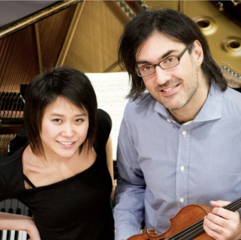|
Back
Aiming For Infinity New York
Isaac Stern Auditorium
11/04/2021 -
Johann Sebastian Bach: Violin Sonata in E Major, BWV 1016
Ferruccio Busoni: Violin Sonata No. 2, opus 36a
Dmitri Shostakovich: Violin Sonata, opus 134
Leonidas Kavakos (Violin), Yuja Wang (Pianist)

Y. Wang, L. Kavakos (© Decca/Benjamin Ealovega)
“I want to attain the unknown. What I already know is boundless. But I want to go even further. The final word still eludes me.”
Ferrucccio Busoni.
After stifled by smothering masks, pulling out Vax cards, showing ID proofs and slipping tickets into alien computer machines, the display of the ebullient Yuja Wang and Leonidas Kavakos on the stage of Carnegie Hall came almost as a magic bullet cure. They are both radiant performers, they can be idiosyncratic (nothing pre-ordained for either of them) but never eccentric. They are unfailingly illuminating, and their light shone down on the almost-full audience.
So why the “almost”? For this listener, every single measure was an elucidation. For many audience members, who left between pieces or even between measures, the recital by these two was unfamiliar, desolate, alien to “a pleasant evening at Carnegie Hall.”
To which I politely reply, “Screw ’em".
Back to the program. The opening Bach Sonata was itself strange. Mr. Kavakos knows his “traditional” Bach, and his performance of three Bach concerti at Caramoor two months ago was stunning. If he played second fiddle (so to speak) to Yuja Wang, with a fairly thin straight tone one feels the original 18th Century performance with a relatively primitive violin might have been the same.
Ms. Wang, though, gave not the slightest allowance to the original harpsichord or early keyboard. From the very beginning, she seemed to say, “Well, this is a Steinway Grand, and I’m gonna make it sound like a Steinway Grand.” Her playing was lyrical, she made the keys resemble the strings of a Gluck opera. True, for the third moment, the Adagio has an almost Romantic passion. For the rest, one was mesmerized by Ms. Wang’s faultless fluidity.
The following Busoni Second Violin Sonata was as unknown to me as the rest of Carnegie Hall. Why isn’t Busoni played more often? One must picture a Picasso body, each segment divided from the other. One of Busoni’s arms an homage to Bach, another an homage to Schoenberg, one pair of fingers loving the insane technique of the artist, the other a love affair with Liszt. One segment, an Italian dancer (yes, he included a tarantella here), another a religious mystic longing for a partnership with the Eternal.
That’s a whole lot for any audience to absorb by using their heads. Instead, they could have used their pure emotions and let the two artists do their work. And work they did! Ms. Wang can be as intense as any old German pianist. Mr. Kavakos showed the same inner strength, brought out (unlike the Bach) to its full volume.
Speaking of Bach, this was another Busoni homage. Busoni not only quoted a Bach chorale, he based the last movement on variations of the chorale. Before that, Messrs Wang and Kavakos were suitably introspective in the opening and gave a dazzling Tarantella second movement.
I was not surprised but annoyed at the audience applause after this Presto. For that finale is so deep and mystical, that one wants perfect silence before it. Busoni himself noted that “tense silence between movements is music”. But the two artists then started with a grand and almost religious finale. The subject was that Bach chorale and variations. Extreme variation with a few short cadenzas for Mr. Kavakos.
The ending three minutes were, by far, the most profound minutes of the evening. A fugue for violin and piano which echoed Bach but which had all the emotions of a Schumann or Liszt. And both gave it all the greatness it deserved.
For this difficult program (no easy familiar music permitted), they went from the mystical bond between Humankind and Eternity to the more pathetic miseries of Dmitri Shostakovich.
This was unfair on my part. Shostakovich was a far better composer. Yet more like Tchaikovsky than Saint Augustine, he dwelt on his own personal problems. And despairing as this was, the work included radiant measures. A demonic middle movement (turning into a Dance of Death), and a final passacaglia which finished with…well, the same empty piano chords which started the work.
The encore was hardly assuaging. A movement from Stravinsky’s Duo Concertant which was aeons away from the ordinary jolly bagatelles which usually end such a recital. In other words, Messrs Kavakos and Wang were narrating not so much fabulous playing but musical ideas over which to muse.
Harry Rolnick
|